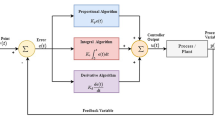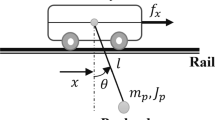Abstract
In this study, the problem of Padé-approximation-based optimal preview repetitive control (POPRC) with equivalent-input-disturbance (EID) for a class of continuous-time uncertain systems is proposed. Firstly, a delay-free state-space representation of the modified repetitive control (MRC) system is constructed using the Padé-approximation method. Then, an augmented dynamic system that incorporates the output of MRC system is established. Subsequently, the POPRC problem transformed into a linear quadratic regulation problem of an augmented dynamic system by introducing a quadratic performance index. To ensure the robustness of the closed-loop system in the presence of external disturbances, the standard EID technique is cooperated with the POPRC law by applying the Separation Theorem. Furthermore, the stability of the overall control system is proved by using small-gain theorem. Compared with the existing result, a simplified POPRC law with EID is obtained for the original system. Finally, simulation results are presented to illustrate the effectiveness and robustness of the controller.













Similar content being viewed by others
References
Li L, Liao FC, Ren Z (2020) Robust tracking control with preview action for uncertain discrete-time systems. Int J Control Autom Syst 18(3):719–729
Sheridan TB (1966) Three models of preview control. IEEE Trans Human Factors Electron 7(2):91–102
Katayama T, Ohki T, Inoue T et al (1985) Design of an optimal controller for a discrete-time system subject to previewable demand. Int J Control 41(3):677–699
Liu YD, Ossareh HR (2021) Preview reference governors: a constraint management technique for systems with preview information. Syst Control Lett 152:104932
Li L, Zhang Y (2021) Distributed preview control for large-scale systems with time-varying delay. ISA Trans 109(1):22–33
Katayama T, Hirono T (1987) Design of an optimal servomechanism with preview action and its dual problem. Int J Control 45(2):407–420
Wu J, Liao FC, Tomizuka M (2017) Optimal preview control for a linear continuous-time stochastic control system in finite-time horizon. Int J Syst Sci 48(1):129–137
Liao YL, Liao FC (2018) Design of preview controller for linear continuous-time systems with input delay. Int J Control Autom Syst 16(3):1080–1090
Shen H, Liu Y A, Wang J et al (2023) Sliding-mode control for IT2 fuzzy nonlinear singularly perturbed systems and its application to electric circuits: a dynamic event-triggered mechanism. IEEE Trans Syst Man Cybern Syst
Chen J (2020) Sliding mode preview control for a class of continuous-time linear systems. Iran J Sci Technol-Trans Electric Eng 44(4):1501–1511
Yu X (2021) Preview tracking control for quasi-one-sided Lipschitz nonlinear systems. J Control Autom Electric Syst 32(6):1439–1448
Inoue T, Nakano M, Iwai S (1981) High accuracy control of servomechanism for repeated contouring. In: Proceedings of the tenth annual symposium on incremental motion, control system and devices, pp 285–292
Hara S, Yamamoto Y, Nakano M et al (2002) Repetitive control system: a new type servo system for periodic exogenous signals. IEEE Trans Autom Control 33(7):659–668
Zhou L, She JH, He Y et al (2016) Aperiodic disturbance rejection in a modified repetitive-control system with non-linear uncertainty. IET Control Theory Appl 10(18):2394–2402
Doh TY, Ryoo JR (2020) Design of repetitive control systems using a delayed control input and a state error. Int J Control Autom Syst 18(12):3242–3246
Sakthivel R, Anusuya S, Harshavarthini S et al (2023) Composite disturbance rejection and tracking control design for fuzzy model based systems with cyber attacks. J Frankl Inst 360(1):403–423
Mooren N, Witvoet G, Oomen T (2022) Gaussian process repetitive control: Beyond periodic internal models through kernels. Automatica 140:110273
Kavikumar R, Ma YK, Ren Y et al (2018) Observer-based \(H_\infty\) repetitive control for fractional-order interval type-2 ts fuzzy systems. IEEE Access 6:49828–49837
Kavikumar R, Sakthivel R, Kwon OM et al (2022) Robust tracking control design for fractional-order interval type-2 fuzzy systems. Nonlinear Dyn 107(4):3611–3628
Freudenberg J, Looze DF (1985) Right half plane poles and zeros and design tradeoffs in feedback systems. IEEE Trans Autom Control 30(6):555–565
Li XD, Chow TWS, Ho JKL (2009) Quasi-sliding mode based repetitive control for nonlinear continuous-time systems with rejection of periodic disturbances. Automatica 45(1):103–108
She JH, Fang M, Ohyama Y et al (2008) Improving disturbance-rejection performance based on an equivalent-input-disturbance approach. IEEE Trans Ind Electron 55(1):380–389
Sweety CWC, Mohanapriya S, Kwon OM et al (2020) Disturbance rejection in fuzzy systems based on two dimensional modified repetitive-control. ISA Trans 106:97–108
Zhou L, She JH, Zhou S et al (2018) Compensation for state-dependent nonlinearity in a modified repetitive control system. Int J Robust Nonlinear Control 28(1):213–226
Nakamura H (1994) Preview-repetitive control using ARMAX models. Control Inf Eng 7(9):347–352
Sato T, Egami T, Tsuchiya T (2005) Design of discrete-time sliding-mode preview-repetitive control systems. Trans Inst Syst Control Inf Eng 18(9):312–321
Li L (2021) Observer-based preview repetitive control for uncertain discrete-time systems. Int J Robust Nonlinear Control 31(4):1103–1121
Lan YH, He JL, Li P et al (2020) Optimal preview repetitive control with application to permanent magnet synchronous motor drive system. J Frankl Inst 357(15):194–10210
Lan Y H, Zhao J Y, She J H (2021) Preview repetitive control with equivalent input disturbance for continuous-time linear systems. IET Control Theory Appl, 1–14
Lan Y H, Wu J Y, She J H (2022) Optimal sliding mode preview repetitive control for continuous-time nonlinear systems. Int J Control, 1–10
Levine WS (2018) The control handbook. CRC Press, Boca Raton
Hunt LR, Meyer G, Su R (1996) Noncausal inverses for linear systems. IEEE Trans Autom Control 41(4):608–611
Verrelli CM, Pirozzi S, Tomei P et al (2015) Linear repetitive learning controls for robotic manipulators by Padé approximants[J]. IEEE Trans Control Syst Technol 23(5):2063–2070
Tomei P, Verrelli CM (2015) Linear repetitive learning controls for nonlinear systems by Padé approximants[J]. Int J Adapt Control Signal Process 29(6):783–804
Zhao JY, Wang ZH, Yan JD et al (2021) Padé-approximation-based preview repetitive control for continuous-time linear systems. Math Probl Eng 2021:1–9
Zhou K, Doyle JC (1998) Essentials of robust control. Prentice Hall, Upper Saddle River
Kimura H (1981) A new approach to the perfect regulation and the bounded peaking in linear multivariable control systems. IEEE Trans Autom Control 26(1):253–270
Anderson BDO, Moore JB (2007) Optimal control: linear quadratic methods. Courier Corporation, Chelmsford
Niel F, Seuret A, Zaccarian L et al (2017) Robust LQR control for stall flutter suppression: a polytopic approach. IFAC-Pap OnLine 50:11367–11372
She JH, Zhou L, Wu M et al (2012) Design of a modified repetitive-control system based on a continuous-discrete 2D model. Automatica 48(5):844–850
Zhou L, Cheng L, She JH et al (2019) Generalized extended state observer-based repetitive control for systems with mismatched disturbances. Int J Robust Nonlinear Control 29(11):3777–3792
Zhou L, She J, Zhou S, Li C (2018) Compensation for state-dependent nonlinearity in a modified repetitive control system. Int J Robust Nonlinear Control 28(1):213–226
Zhou L, She JH, Zhang XM et al (2020) Improving disturbance-rejection performance in a modified repetitive-control system based on equivalent-input-disturbance approach[J]. Int J Syst Sci 51(1):49–60
Acknowledgements
This work was supported in part by the National Natural Science Foundation of China under Grant 61573298 and the Natural Science Foundation of Hunan Province under Grant 2020JJ6037.
Author information
Authors and Affiliations
Corresponding author
Additional information
Publisher's Note
Springer Nature remains neutral with regard to jurisdictional claims in published maps and institutional affiliations.
Rights and permissions
Springer Nature or its licensor (e.g. a society or other partner) holds exclusive rights to this article under a publishing agreement with the author(s) or other rightsholder(s); author self-archiving of the accepted manuscript version of this article is solely governed by the terms of such publishing agreement and applicable law.
About this article
Cite this article
Lan, YH., Zhao, JY. Improving Track Performance by Combining Padé-Approximation-Based Preview Repetitive Control and Equivalent-Input-Disturbance. J. Electr. Eng. Technol. (2024). https://doi.org/10.1007/s42835-024-01830-x
Received:
Revised:
Accepted:
Published:
DOI: https://doi.org/10.1007/s42835-024-01830-x




